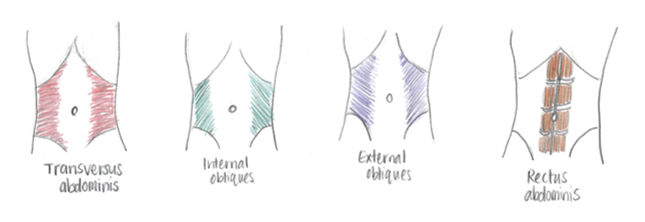
Sophie Pacek
Exercise Physiologist, Healthy Connections
As I have mentioned in previous blogs, my partner and I have returned to outdoor rock climbing in recent weeks. The weather was not ideal last weekend so we decided to attend our local indoor climbing gym instead. Indoor climbing is slightly different to outdoor (mainly that it doesn’t require the safety setup so you are able to climb more in a short period of time), and this was evident in the few days after when I felt quite sore in my abs.
The abdominal muscles play an integral part in supporting, strengthening and stabilising our trunk but can be overlooked when performing exercise. Many believe sit-ups are the go-to abs sculptor, but this group is much more complex than that. Let’s explore further.
A quick anatomy lesson – the ‘abs’ muscle group
Our ‘abs’ are a group of four muscles:
- The rectus abdominis is our “six pack” muscle and allows us to bend forward and sit up.
- The internal obliques and the external obliques are our ‘side abs’ that help us rotate through our trunk as well as bend to one side.
- The transversus abdominis (TA) is the deepest ab muscle, which is integral in providing low back support and trunk stability.

This muscle group extends from the bottom of our ribcage, around to our spine, and insert into our pelvis. Whilst having their individual actions, these muscles work together to provide the three ‘S’s – SUPPORT, STRENGTH and STABILITY.
Core vs. abs: are they the same?
It is easy to get confused about what the ‘core’ is because these two terms are often used interchangeably. Abs technically refer to the entire muscle group whilst the term ‘core’ specifically denotes another group of muscles that include the TA, multifidis (muscles that run along back of spine), diaphragm and pelvic floor muscles. These muscles form a cylindrical shape in our abdomen and are responsible for providing central stability.

Why is our core important?
Think of the core as the corset that connects our upper and lower body – if it is loose, it provides no support to our posture, lower back and overall stability. Our trunk is able to move too much out of our centre of gravity, causing unsteadiness. If it is well fitted (i.e. strong), it provides us with a solid centre – we can sit and stand upright and remain stable with movement.
- Support - the TA wraps around to attach onto our lower spine which explains why individuals who experience low back pain are often prescribed exercises that strengthen this muscle. Research suggests that a ‘sleepy’ core which is slow to wake up at onset of movement is associated with chronic low back pain (Marshall & Murphy, 2010). Core activation exercises refer specifically to movements that will switch on the core whilst exercises like crunches and planks will be working the entire abdominal muscle group.
- Strength and Stability – you may have noticed that balance exercises become easier if you activate your core. This can be explained by the corset analogy – if we are strong and stable through our central area, our centre of gravity remains within our base of support, meaning that we are less likely to feel off-balance. The core is also an important stabiliser while we move – for instance, a football player needs core stability to evade opponents quickly and a gymnast needs a strong centre to remain steady in a tricky position.
Why are the other abdominal muscles important?
The other abdominal muscles are important for all of the same reasons! However, they play a more significant role in muscle toning and strength of our trunk.
“I’ve heard Healthy Connections exercise physiologists say ‘activate your core’ in many exercises. What does that actually mean?”
The core is fundamental in providing support, strength and stability in all postures and movements. “Activating your core” refers to contracting your TA and pelvic floor muscles, which can be quite difficult if unaccustomed or new to this type of movement/feeling. Stay tuned for next week’s blog where I will explain how to activate your core and what it should feel like.
We recommend activating your core with any movement that contains a load and/or balance element, especially if you are prone to back pain. For example, lifting up heavy grocery bags onto the kitchen bench or raising one leg to put on pants. If the core is weak or not active, injury and instability may occur.
So what exercises should I do?
This depends on the individual but generally everyone should allocate a portion of their strength training to abdominal work. It is important to strengthen each muscle within this group (not just your TA and not just your six pack).
In next week’s blog, I will provide you with exercises that specifically target each muscle of the abdominal group including the core. If you have an existing back or abdominal injury, please seek individual advice from one of the exercise physiologists at Healthy Connections.
Until next week, stay safe, wash your hands, and keep moving!
Sophie
References
- Marshall, P., & Murphy, B. (2010). Delayed abdominal muscle onsets and self-report measures of pain and disability in chronic low back pain. Journal of Electromyography and Kinesiology, 20(5), 833-839. https://doi.org/10.1016/j.jelekin.2009.09.005



